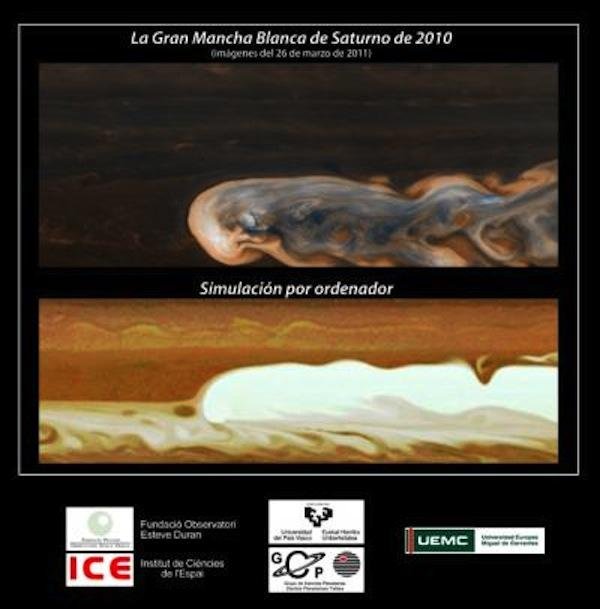Above, a false color image of the storm on Saturn is shown. Below is a computer simulation of the storm. The white clouds superimposed on the real background of the planet's clouds represent the result of the evolution in the storm's aspect on its interaction with Saturn's winds. (Credit: UPV/EHU)
Approximately once every Saturnian year -- equivalent to 30 Earth years -- an enormous storm appears on the ringed planet and affects its atmosphere on a global scale.
The nature of these storms, known as Great White Spots, has been explained for the first time by researchers from the Planetary Sciences Group of the University of the Basque Country.
Called Great White Spots due to their appearance on the atmosphere of the planet, the phenomenon was first observed in 1876. The Great White Spot of 2010 was the sixth to be observed, and was captured by the Cassini space probe belonging to the North American and European space agencies (NASA and ESA).
Analysis of high-resolution images showed the meteorological structure began as a "small brilliant white cloud" in the middle latitudes of the northern hemisphere of the planet. It grew quickly and remained active for more than seven months.
Over this time, and amalgam of white clouds expanded and formed a turbulent ring with a surface area of thousands of millions of square kilometers.
The Planetary Sciences Group presented a first study of the storm which was published on the front cover of Nature in July, 2011. In the latest study, astronomers analyzed Cassini images to measure the winds in the "head" of the storm, the focus where the activity originated.
"We did not expect to find such violent circulation in the region of the development of the storm, which is a symptom of the particularly violent interaction between the storm and the planet's atmosphere", commented Enrique Garcia, lead author of the study, published in Nature Geoscience.
The head of the storm interacts with the planet's atmosphere forming intense sustained winds, typically some 500 kilometers an hour, at 40 kilometers above the planet's own clouds.
Researchers designed mathematical models to reproduce the storm on a computer, providing a physical explanation for its behavior, size and duration. Their calculations show that the focus of the storm is embedded about 300 kilometers above the visible clouds.
The storm transports enormous quantities of moist gas in water vapor to the highest levels of the planet, forming visible clouds and liberating enormous quantities of energy.
The research also showed that the activity of the enormous storm was not able to substantially modify the prevailing winds -- which blow permanently in the same direction as Earth's parallels -- but they did interact violently with them.















